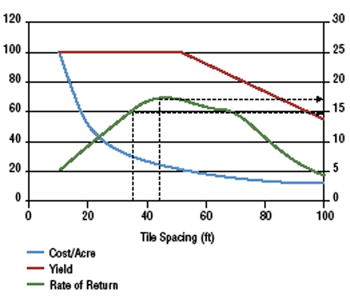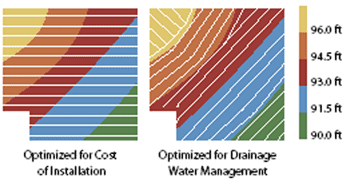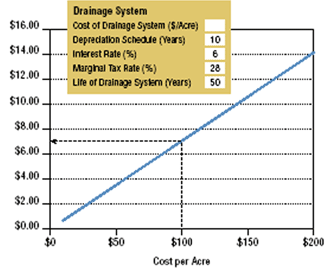Economic Aspects of Drainage and Water Management
 |
Richard CookeAssociate Professor of Agricultural EngineeringPhone: (217) 333-0944 E-mail: r-cooke@illinois.edu |
||
For many Illinois farmers in the mid 19th to mid 20th century, there was no question as to the importance of drainage. In many areas of the state, drainage was necessary for timely planting and harvesting, and for reducing water logging and yield variations. However, the benefits of drainage are not as obvious to today's farmers. Thanks to the efforts of the early pioneers most farms have some degree of drainage. The main question now becomes whether or not the benefits of any drainage improvement outweighs the costs. Drainage is thus primarily an economic decision. There are also questions relating to water quality. Water quality degradation associated with drainage improvement can be viewed as a cost to society. While there is no easy way to evaluate these costs, drainage systems can be designed to ensure a reasonable return on investment while minimizing adverse environmental effects.
Optimizing Tile Spacing
The cost of a drainage system increases as the tile spacing decreases. For the most part, potential yield also increases with decreasing tile spacing. However, there is a threshold spacing beyond which no yield benefits can be obtained by putting the tiles closer together. The relationship between spacing and average installation cost is shown in Figure 1. Also shown is the relationship between computer simulated yield from a silt loam and spacing, using 30 years of weather data from Urbana. While the yield ratio varies with soil type and location, and the cost ratio varies with the contractor, the general form of the curves are representative of what can be expected in Illinois.
The yield and the cost curves can be used to determine the spacing that maximizes the rate of return on the investment in drainage. In this instance the maximum rate of return was 17%, obtained at a spacing of 45 ft. If the spacing were reduced to 35 ft so as to improve the quality of the drain effluent, the rate of return on the drainage investment would drop to 15%. This is still a substantial rate of return for the producer. Further benefits would also accrue from the improvement in downstream water quality.
Drainage Water Management
In drainage water management, a control structure is placed at the outlet of a tile system to control the level of the water table in the soil. This practice can be used to raise the water level after harvest, thereby reducing nitrate loading from tile effluent, or to retain water in the soil during the growing season. The normal mode of operation in Illinois is to set the water table control height to within 6 inches of the soil surface on November 1, and to lower the control height to the level of the tile on March 15. Thus, water is held back in the field during the fallow period. In experiments in Illinois, reductions of up to 46.6 % and 82.5 % were measured for nitrate and phosphate, respectively.
Existing drainage systems can be retrofitted for drainage water management by installing control structures at a cost of $20–$40 per acre. For new systems addition costs are incurred by laying out the drainage systems to optimize the benefits of drainage water management. In Illinois, drainage systems are normally laid out to minimize the cost of installation. However, such installations do not necessarily maximize the benefits of drainage water management.
Shown in Figure 1 are two possible drainage systems that could be installed on the same field. In all likelihood, this lower cost system would be the one selected for installation. In this instance, based on average installations costs, the difference in cost is $75/acre.
Drainage water management systems can be managed so that they store water during the growing season. This stored water can result in increased yields. One relationship between the additional cost of a drainage water management system and the corresponding breakeven income is shown in Figure 3. A system that cost $100/acre, for example, has a breakeven income of $7.05. Thus, it does not take a large yield increase to pay for the installation of a drainage water management system.
Drainage Calculator
The new edition of the Illinois Drainage Guide includes a drainage calculator that can be used to determine the rate of return associated with an investment in drainage. It can also be used to determine breakeven income and discounted and undiscounted payback periods. (The discounted payback period takes the time value of money into consideration, with future income being converted to its present value based on interest rates).
Tables & Figures
 |
Figure 1. Simulated tile spacing/cost/yield
relationship. |
 |
Figure 2. Effect of design objective
on drainage system layout. |
 |
Figure 3. Relationship between cost and breakeven
income for a drainage water management system. |